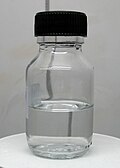
Back Mieresuur Afrikaans حمض الفورميك Arabic Qarışqa turşusu Azerbaijani اسید فرمیک AZB Мурашыная кіслата Byelorussian Мравчена киселина Bulgarian Mravlja kiselina BS Àcid fòrmic Catalan Kyselina mravenčí Czech Asid fformig Welsh
| |||

| |||
| Names | |||
|---|---|---|---|
| Preferred IUPAC name
Formic acid[1] | |||
| Systematic IUPAC name
Methanoic acid[1] | |||
Other names
| |||
| Identifiers | |||
3D model (JSmol)
|
|||
| 1209246 | |||
| ChEBI | |||
| ChEMBL | |||
| ChemSpider | |||
| DrugBank | |||
| ECHA InfoCard | 100.000.527 | ||
| EC Number |
| ||
| E number | E236 (preservatives) | ||
| 1008 | |||
| KEGG | |||
PubChem CID
|
|||
| RTECS number |
| ||
| UNII | |||
CompTox Dashboard (EPA)
|
|||
| |||
| |||
| Properties | |||
| CH2O2 | |||
| Molar mass | 46.025 g·mol−1 | ||
| Appearance | Colorless fuming liquid | ||
| Odor | Pungent, penetrating | ||
| Density | 1.220 g/mL | ||
| Melting point | 8.4 °C (47.1 °F; 281.5 K) | ||
| Boiling point | 100.8 °C (213.4 °F; 373.9 K) | ||
| Miscible | |||
| Solubility | Miscible with ether, acetone, ethyl acetate, glycerol, methanol, ethanol Partially soluble in benzene, toluene, xylenes | ||
| log P | −0.54 | ||
| Vapor pressure | 35 mmHg (20 °C)[2] | ||
| Acidity (pKa) | 3.745[3] | ||
| Conjugate base | Formate | ||
| −19.90×10−6 cm3/mol | |||
Refractive index (nD)
|
1.3714 (20 °C) | ||
| Viscosity | 1.57 cP at 268 °C | ||
| Structure | |||
| Planar | |||
| 1.41 D (gas) | |||
| Thermochemistry | |||
Std molar
entropy (S⦵298) |
131.8 J/mol K | ||
Std enthalpy of
formation (ΔfH⦵298) |
−425.0 kJ/mol | ||
Std enthalpy of
combustion (ΔcH⦵298) |
−254.6 kJ/mol | ||
| Pharmacology | |||
| QP53AG01 (WHO) | |||
| Hazards | |||
| Occupational safety and health (OHS/OSH): | |||
Main hazards
|
Corrosive; irritant; sensitizer | ||
| GHS labelling: | |||
 
| |||
| Danger | |||
| H314 | |||
| P260, P264, P280, P301+P330+P331, P303+P361+P353, P304+P340, P305+P351+P338, P310, P321, P363, P405, P501 | |||
| NFPA 704 (fire diamond) | |||
| Flash point | 69 °C (156 °F; 342 K) | ||
| 601 °C (1,114 °F; 874 K) | |||
| Explosive limits | 14–34%[citation needed] 18–57% (90% solution)[2] | ||
| Lethal dose or concentration (LD, LC): | |||
LD50 (median dose)
|
700 mg/kg (mouse, oral), 1100 mg/kg (rat, oral), 4000 mg/kg (dog, oral)[4] | ||
LC50 (median concentration)
|
7853 ppm (rat, 15 min) 3246 ppm (mouse, 15 min)[4] | ||
| NIOSH (US health exposure limits): | |||
PEL (Permissible)
|
TWA 5 ppm (9 mg/m3)[2] | ||
REL (Recommended)
|
TWA 5 ppm (9 mg/m3)[2] | ||
IDLH (Immediate danger)
|
30 ppm[2] | ||
| Safety data sheet (SDS) | MSDS from JT Baker | ||
| Related compounds | |||
Related carboxylic acids
|
Acetic acid Propionic acid | ||
Related compounds
|
Formaldehyde Methanol | ||
| Supplementary data page | |||
| Formic acid (data page) | |||
Except where otherwise noted, data are given for materials in their standard state (at 25 °C [77 °F], 100 kPa).
| |||
Formic acid (from Latin formica 'ant'), systematically named methanoic acid, is the simplest carboxylic acid, and has the chemical formula HCOOH and structure H−C(=O)−O−H. It is an important intermediate in chemical synthesis and occurs naturally, most notably in some ants. Esters, salts and the anion derived from formic acid are called formates. Industrially, formic acid is produced from methanol.[5]
- ^ a b Favre, Henri A.; Powell, Warren H. (2014). Nomenclature of Organic Chemistry : IUPAC Recommendations and Preferred Names 2013 (Blue Book). Cambridge: The Royal Society of Chemistry. p. 745. doi:10.1039/9781849733069. ISBN 978-0-85404-182-4.
- ^ a b c d e NIOSH Pocket Guide to Chemical Hazards. "#0296". National Institute for Occupational Safety and Health (NIOSH).
- ^ Smith, Robert M.; Martell, Arthur E. (1989). Critical Stability Constants Volume 6: Second Supplement. New York: Plenum Press. p. 299. ISBN 0-306-43104-1.
- ^ a b "Formic acid". Immediately Dangerous to Life or Health Concentrations (IDLH). National Institute for Occupational Safety and Health. 4 December 2014. Retrieved 26 March 2015.
- ^ "Formic acid". American Chemical Society. Retrieved 21 November 2023.
© MMXXIII Rich X Search. We shall prevail. All rights reserved. Rich X Search


